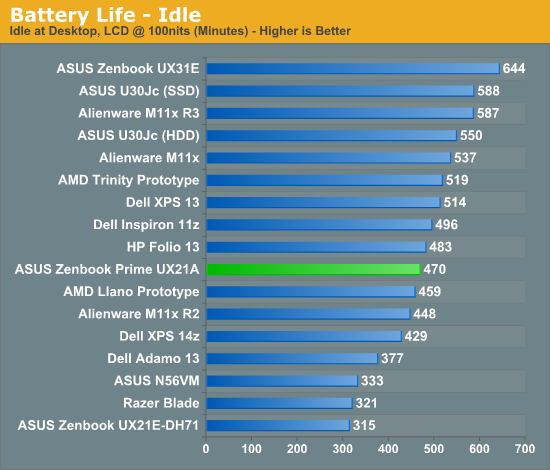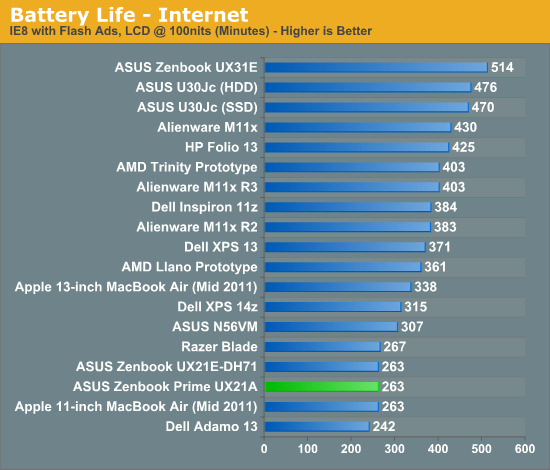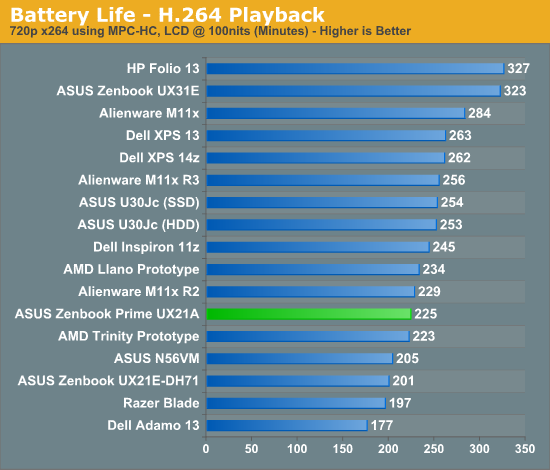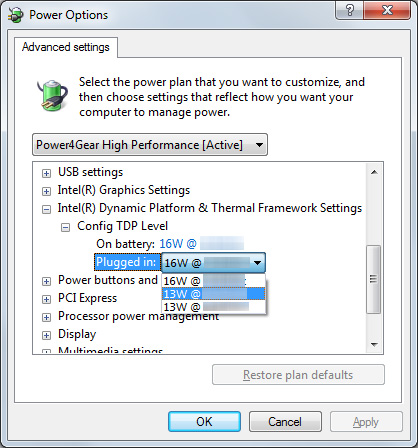ASUS Zenbook Prime (UX21A) Review: The First of the 2nd Gen Ultrabooks
by Anand Lal Shimpi on May 22, 2012 2:46 PM EST- Posted in
- Laptops
- CPUs
- Asus
- Ivy Bridge
- Zenbook
- Zenbook Prime
- Ultrabook
- Notebooks
Battery Life
Generally speaking, the 11-inch Zenbook Prime delivers about the same amount of battery life as its predecessor. For some reason we're able to hit much longer idle battery life on the Prime than the original Zenbook although I'm still trying to find out why. There's also an 11% improvement in our x264 playback test, but on average I'd expect to see similar battery life to the Sandy Bridge model - just with better performance. Note that these results also come despite the fact that ASUS is driving a much higher resolution, and presumably higher power, display than the original Zenbook.



The Zenbook Prime bucks the trend Jarred saw with the first Ivy Bridge notebook review where battery life took a small step backwards. These results bode well for future Ivy Bridge notebooks and Ultrabooks. It still remains to be seen if Intel's 22nm process will actually give us a battery life advantage in any notebook compared to its predecessor. It's possible that we are seeing some of the benefits of 22nm here already and they are simply offset by the more power hungry display. With the move to 22nm Intel should have a better hold on active power and leakage, but it's always possible that we'll have to wait until Haswell for the process to really be exploited.
Just like last time, ASUS has a couple of widgets to quickly change between power settings. The instant on widget lets you switch between suspend to RAM and suspend to disk modes. The former is expected to deliver up to 2 weeks of standby battery life, while the latter can push up to 150 days. I didn't have the time to test these claims (life is short, I draw the line at spending it testing claims of 150 day standby battery life). ASUS once again includes a counter that estimates how long your system will last in either mode based on current charge levels and power usage.
The next widget is a quick tool to let you switch between high performance and battery saver Power4Gear power profiles. You can customize these profiles via the Windows control panel, but it's nice to have a button on the desktop that lets you quickly switch between them.
Configurable TDP
One feature of Ivy Bridge that we haven't been able to test until now is configurable TDP. While most Ultrabook CPUs ship with a 17W TDP, that's mostly an arbitrary thermal/power rating. If an OEM wants to design a chassis that can only accept a 13W part it previously had to hope that Intel would make such a thing. Alternatively, the OEM could underclock/undervolt a 17W chip on their own and hope to mimic Intel's validation and deliver a 13W configuration of their own. The former requires that a significant number of OEMs demand the part, while the latter is just too risky for the larger OEMs (get too aggressive on the undervolting side and end up with a bunch of unstable systems). The solution Intel proposed with Ivy Bridge is configurable TDP. For Ultrabooks this means you can set a 17W part to 13W.

Currently the setting is hidden away in Windows 7's power management settings. Once again I've had to censor the clock speeds here due to Intel's Ultrabook embargo:
You can map the 13W settings to the battery saver profile and then, at the click of a button, have a 13W Zenbook Prime instead of a 17W model. The difference in performance isn't significant however:
| ASUS Zenbook Prime Configurable TDP Performance - Cinebench 11.5 (Multithreaded) | |||||||
| 16W - Max Freq | 13W - Mid Freq | 13W - Lowest Freq | |||||
| ASUS Zenbook Prime UX21A | 2.79 | 2.67 | 2.67 | ||||
I'm still running battery life tests to quantify the impact on power consumption, but it's conceptually a neat thing to see in action finally. I suspect configurable TDP is going to play a major role with Haswell and convertible/dockable Ultrabook-tablet hybrids.
Thermals and Noise
As with most high performance notebooks that are this thin, cooling is difficult. Under load the fans in the Zenbook Prime are definitely audible, but in general ASUS does a better job cooling everything inside the Zenbook Prime than Apple does in the MacBook Air. I suspect much of this boils down to how aggressive Apple is about keeping fan speed/noise down compared to ASUS' desire to maintain a certain temperature level inside the chassis.










192 Comments
View All Comments
zappb - Sunday, May 27, 2012 - link
11 inch 1080p = Asus = Awesome...That just takes some balls!
Thanks Asus
stoked - Sunday, May 27, 2012 - link
Can someone comment on the difference between the UX31A-DB51 and UX31A-DB52 for the $100 difference in price?Rudyji - Wednesday, September 19, 2012 - link
51 : i5 128gig SSD52 : i5 256gig SSD
71 : i7 128gig SSD
72 : i7 256gig SSD
Rudyji - Wednesday, September 19, 2012 - link
or maybe its the RAM...it isnt all that clear....shriganesh - Monday, May 28, 2012 - link
The high res screen rocks. There is another albeit unconventional one. We can reduce the resolution. In fact I am not too comfortable with 1080P resolution in my 23" monitor. So I use it with 720p resolution which has least artifacts due to more physical dots showing less number of pixels. There sure are artifacts and jagged lines which make the text and things less sharp. But it puts extremely low stress on eyes.waqqashanafi - Monday, May 28, 2012 - link
I can't wait to get my hands on one of these Zenbook Primes. The only issue I have with such a mobile laptop is the lack of the obvious: 4G LTE!A laptop like this NEEDS to have 4G LTE built-in, in this day when mobile data is cheap and available everywhere, and people are more and more mobile. I want to be able to just flip this bad boy open anywhere (offices, cafes, in the car, park, friend's house, etc.) without having to beg for other people's WiFi passwords - or have ugly fat 4G LTE dongles sticking out of my laptop or do some shaky tethering with my phone.
Filiprino - Monday, May 28, 2012 - link
I've read on a lot of sites that the UX32VD has a mini displayport instead of a mini vga. The only ones that have a mini vga are the revisions of UX21E and UX31E, that is, the UX21A and UX31A.igneshto1 - Sunday, June 3, 2012 - link
http://www.youtube.com/watch?v=xD2MnzoirNIThis video(In russian, I know!) goto 3:08... i7-3517U @ 1,90Ghz up to 2,40Ghz... Just so you know...
jonyah - Tuesday, June 5, 2012 - link
These ultrabooks are so close to being great, but they miss the mark. Limiting your machine to 4gb of memory, or putting in a hybrid drive where you should have an ssd really sucks. make it 8gb of memory at least (more would be better), keep the full hd screen and stick with just pure SSD and you have a winner. It may even compete with my Vaio Z enough for me to pick one up instead of a new Z next time. I want a U31A with 8gb of memory. How hard is that? Or the UX32VD with 8gb of memory and 256gb SSD.smartypnt4 - Thursday, June 7, 2012 - link
Get a UX32VD, pick your favorite 256gb drive, grab a 4gb stick of memory (or an 8gb stick if it supports it) and upgrade the thing yourself.The UX32-series all has one stick of user-replaceable RAM, and a user-replaceable HDD that's a standard 2.5" drive. Make sure it's a slim 7mm drive, though. All of Intel's drives are 7mm drives with spacers to make them 9.5mm, so they all fit. Not sure about others.
If I get a new laptop any time soon, that's my plan anyway. It'll be around $1700, but if you're already looking at the Vaio Z, then that won't be too high a price point for you. With this, you get on-board discrete graphics too.